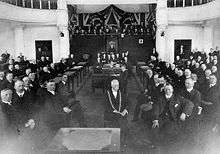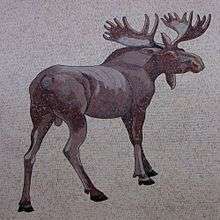Canadian Museum of Nature
| Canadian Museum of Nature | |
|---|---|
| Victoria Memorial Museum Building | |
|
The Victoria Memorial Museum Building | |
| General information | |
| Type | Museum |
| Architectural style | Gothic Revival, Scottish baronial. |
| Location | 240 McLeod Street, Ottawa, Ontario, Canada |
| Coordinates | 45°24′46″N 75°41′20″W / 45.41266°N 75.68875°WCoordinates: 45°24′46″N 75°41′20″W / 45.41266°N 75.68875°W |
| Current tenants | Canadian Museum of Nature |
| Construction started | 1905 |
| Completed | 1912 |
| Owner | Government of Canada |
| Design and construction | |
| Architect | David Ewart |
| Official name | Victoria Memorial Museum Building |
| Designated | 1990 |
The Canadian Museum of Nature (French: Musée canadien de la nature) is a natural history museum in Ottawa, Ontario, Canada. Its collections, which were started by the Geological Survey of Canada in 1856, have branched out to include life sciences. The Museum is affiliated with the Canadian Museums Association, the Canadian Heritage Information Network, and the Virtual Museum of Canada.
Exhibits
The exhibits and main programmes are housed in the Victoria Memorial Museum Building in Ottawa.
The permanent galleries are:
- Fossil Gallery - skeletons and dioramas about dinosaurs and the events that led to their extinction and the rise of mammals approximately 85 to 35 million years ago.
- Earth Gallery - minerals and rocks, and how geological forces have shaped our planet.
- Mammal Gallery - Canada's wild animals, including mounts of grizzly bears, bison, moose, caribou, pronghorns and cougars.
- Water Gallery - features a blue whale skeleton, exhibits about life found in marine and fresh waters and the critical role that water plays in sustaining all living things.
- Bird Gallery - features over 450 Canadian bird mounts, multimedia experiences and interactive displays.
- Nature Live - live insects, arachnids and slugs.
- Stone Wall Gallery - changing displays of art and photography about natural science
Natural Heritage Campus
The Natural Heritage Campus in Gatineau, Quebec, opened in 1997, is the site of the administrative, research and collections operations.[1] It is not open to the public except for an annual Open House. The library, however, does allow for visitors.[2]
History
The Canadian Museum of Nature has its origins in the Geological Survey of Canada, which was formed in 1842. Nearly 150 years later, on July 1, 1990, the museum became a Crown Corporation by an Act of Parliament.
The Museums Act was a significant event in the history of the museum. With Crown Corporation status came a new name, a new "arms-length" status and an expanded mandate. "The purpose of the Canadian Museum of Nature is to increase throughout Canada and internationally, interest in, knowledge of and appreciation and respect for the natural world by establishing, maintaining and developing for research and posterity a collection of natural history objects, with special but not exclusive reference to Canada, and by demonstrating the natural world, the knowledge derived from it and the understanding it represents." –[3]
The building


The building, known as the Victoria Memorial Museum Building, was built in former farm fields known as Appin Place, the estate of the Scottish-born merchant William Stewart. The neighbourhood became known as Stewarton and residential development started in the area during the 1870s.[4] The government purchased the land in 1905 hoping to develop the site as a sort of 'end piece' to complement the stone structure of the Canadian Parliament Buildings at the opposite end of Metcalfe Street, on Parliament Hill.[5]
This massive stone structure is an excellent example of early 20th-century architecture in Ottawa, and was built for $1,250,000 by architect David Ewart who is responsible for many similar structures around the city.[5] The construction of the building involved the importing of 300 skilled stonemasons from Scotland.[5] The architectural style is sometimes described as Scottish baronial. Ewart was sent to Britain to study the architecture of Hampton Court and Windsor Castle, which greatly influenced his design of this building.[6]
Unfortunately, because of the presence of unstable Leda clay in the geology of the site, a tall tower that was situated at the front of the building had to be taken down in 1915 due to settling and the concern that the foundation could not support the weight. The unstable site forced some workers to stop working, as shifting foundations in the basement shot bricks and stones out from the walls, hitting some construction workers.
The building found itself filling a more auspicious role than originally intended when in 1916, fire consumed the majority of the Centre Block on Parliament Hill. The recently completed Victoria Museum Building became the temporary home of the House of Commons from 1916 to 1919 and the affairs of the government were run from the site until the completion of the new Parliament building in 1922.[5][7] The Senate used the first floor mineral room (now the Fossil Gallery) and the Commons used the amphitheatre on third floor (now the Salon). Chairs and tables for members were brought in, as well as the speaker's chair for both the Senate and Commons.
In 1986, the National Museum that occupied the building was split into the National Museum of Natural Sciences (eventually renamed the Canadian Museum of Nature) and the National Museum of Man (renamed the Canadian Museum of Civilization, and later the Canadian Museum of History), although both entities continued to share the same edifice. In 1989, the then Canadian Museum of Civilization moved to a new location in Gatineau, Quebec, and the Canadian Museum of Nature was able to occupy the entire Victoria Memorial Museum Building.
The Victoria Memorial Museum building was designated a National Historic Site of Canada in 1990.[8][9]
A major renovation of all parts of the building began in 2004 and was completed in 2010, including a glass "lantern" taking the place of the tower removed in 1915. The weight of the new tower is cantilevered off the new elevator shafts; the building itself does not support the new tower. For most of the duration of the renovation, parts of the building were still open to the public, but the entire building was closed temporarily on 26 April 2010 for final changes. The newly renovated museum re-opened again on 22 May 2010, and the lantern structure was christened the "Queens' Lantern" in honour of both Elizabeth II, who visited the building on her 2010 royal tour, and Queen Victoria.[10][11][12]
Famous Tenants
Over the decades, the Canadian Museum of Nature has shared the Victoria Memorial Museum Building with a number of notable tenants:[13]
- In 1916, the building became the emergency headquarters for the Canadian government after the Parliament Buildings were consumed by a great fire.
- When former Prime Minister Sir Wilfrid Laurier died in 1919, his body was lain in state in the museum auditorium.
Three major museums had their start at the castle: The National Gallery of Canada, the Canadian Museum of History and the Canada Science and Technology Museum.
In 1988 the castle became the exclusive home of the Canadian Museum of Nature.
National Herbarium of Canada
The National Herbarium of Canada[15] is housed within the Canadian Museum of Nature. The plant collections of the Geological and Natural History Survey of Canada were officially incorporated into the museum in 1882.[15] There are several distinct collections (numbers valid as of 2016):
- Vascular plant collection with 1 950 729 specimens, including about 2500 type specimens.[15]
- Lichen and Allied Fungi collection with 272 356 specimens, including about 750 type specimens.[15]
- Bryophyte collection contains 539 768 specimens, and 950 type specimens.[15]
- Algae collection contains 3 016 440 specimens and 300 type specimens. It is kept in the National Phycology Collection of Canada.[15]
- Macroalgae collection contains 26 640 specimens. It is kept in the National Phycology Collection of Canada.[15]
See also
References
- ↑ "Our Research and Collections Facility". Canadian Museum of Nature. Retrieved 3 December 2014.
- ↑ "Library and Archives". Canadian Museum of Nature. Retrieved 3 December 2014.
- ↑ from the Museums Act, Chapter M-13.4 (1990, c. 3)
- ↑ Kalmam, 52.
- 1 2 3 4 Fletcher, 148.
- ↑ Kalman, 52.
- ↑ "Parks Canada - Meetings of Parliament". Pc.gc.ca. 2005-02-22. Retrieved 2011-02-26.
- ↑ Victoria Memorial Museum, Directory of Designations of National Historic Significance of Canada
- ↑ Victoria Memorial Museum, National Register of Historic Places
- ↑ Canadian Museum of Nature - Grand Reopening Archived April 11, 2010, at the Wayback Machine.
- ↑ Cook, Maria (2010-05-16). "''Ottawa Citizen'' - The Wonders of Nature". Ottawacitizen.com. Retrieved 2011-02-26.
- ↑ Canada. "Her Majesty Queen Elizabeth II Marks the Naming of the "Queens' Lantern" at the Canadian Museum of Nature". Nature.ca. Retrieved 2011-02-26.
- ↑ "Museum History". Canadian Museum of Nature. Retrieved 22 November 2014.
- ↑ Extreme Make-over for Ottawa's Nature Museum, Canadian Geographic
- 1 2 3 4 5 6 7 National Herbarium of Canada
Further reading
- Ray, Randy, The Big Book of Canadian Trivia, Dundurn Pres, ISBN 978-1-55488-417-9
External links
| Wikimedia Commons has media related to Canadian Museum of Nature. |
